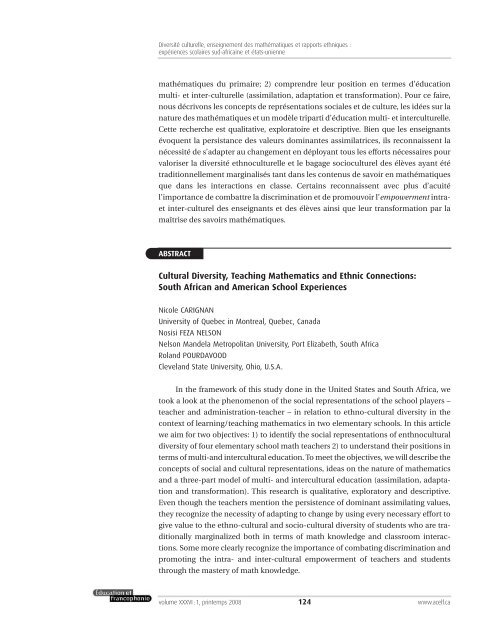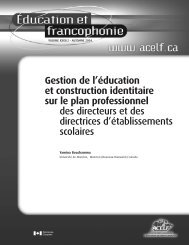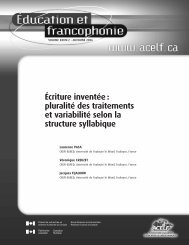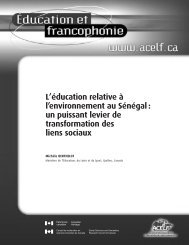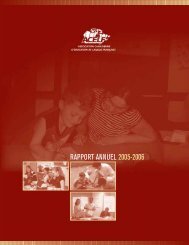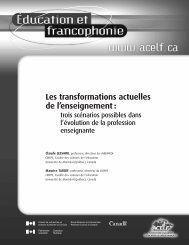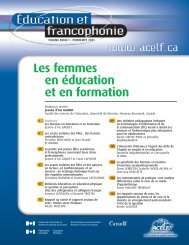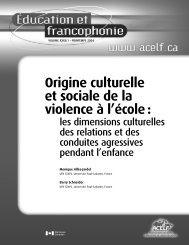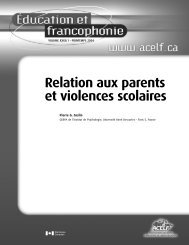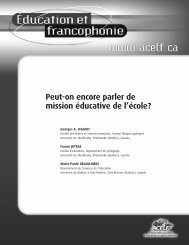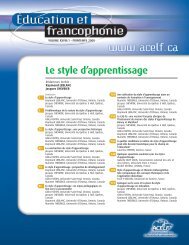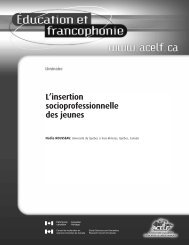You also want an ePaper? Increase the reach of your titles
YUMPU automatically turns print PDFs into web optimized ePapers that Google loves.
Diversité culturelle, enseignement des mathématiques et rapports ethniques :expériences scolaires sud-africaine et états-uniennemathématiques du primaire; 2) comprendre leur position en termes d’éducationmulti- et inter-culturelle (assimilation, adaptation et transformation). Pour ce faire,nous décrivons les concepts de représentations sociales et de culture, les idées sur lanature des mathématiques et un modèle triparti d’éducation multi- et interculturelle.Cette recherche est qualitative, exploratoire et descriptive. Bien que les enseignantsévoquent la persistance des valeurs dominantes assimilatrices, ils reconnaissent lanécessité de s’adapter au changement en déployant tous les efforts nécessaires pourvaloriser la diversité ethnoculturelle et le bagage socioculturel des élèves ayant ététraditionnellement marginalisés tant dans les contenus de savoir en mathématiquesque dans les interactions en classe. Certains reconnaissent avec plus d’acuitél’importance de combattre la discrimination et de promouvoir l’empowerment intraetinter-culturel des enseignants et des élèves ainsi que leur transformation par lamaîtrise des savoirs mathématiques.ABSTRACTCultural Diversity, Teaching Mathematics and Ethnic Connections:South African and American School ExperiencesNicole CARIGNANUniversity of Quebec in Montreal, Quebec, CanadaNosisi FEZA NELSONNelson Mandela Metropolitan University, Port Elizabeth, South AfricaRoland POURDAVOODCleveland State University, Ohio, U.S.A.In the framework of this study done in the United States and South Africa, wetook a look at the phenomenon of the social representations of the school players –teacher and administration-teacher – in relation to ethno-cultural diversity in thecontext of learning/teaching mathematics in two elementary schools. In this articlewe aim for two objectives: 1) to identify the social representations of enthnoculturaldiversity of four elementary school math teachers 2) to understand their positions interms of multi-and intercultural education. To meet the objectives, we will describe theconcepts of social and cultural representations, ideas on the nature of mathematicsand a three-part model of multi- and intercultural education (assimilation, adaptationand transformation). This research is qualitative, exploratory and descriptive.Even though the teachers mention the persistence of dominant assimilating values,they recognize the necessity of adapting to change by using every necessary effort togive value to the ethno-cultural and socio-cultural diversity of students who are traditionallymarginalized both in terms of math knowledge and classroom interactions.Some more clearly recognize the importance of combating discrimination andpromoting the intra- and inter-cultural empowerment of teachers and studentsthrough the mastery of math knowledge.volume XXXVI:1, printemps 2008124www.<strong>acelf</strong>.ca


